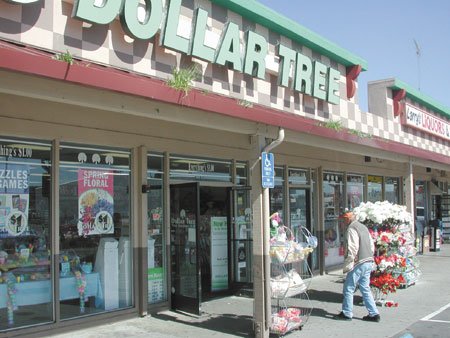President Bush says it’s not a recession, but admits the economy
has slowed.
President Bush says it’s not a recession, but admits the economy has slowed.
With no relief at the pump or in the housing market, and wholesale prices on the rise, some consumers are turning to discount and low-price stores to save a buck or two. Increased sales at retailers such as Ross Stores and record profits at low-price giant Wal-Mart might prove the trend true.
For some residents, shopping at discount and low-price stores is part of everyday life.
Robbie Kinder said he shops occasionally at the Dollar Tree Store on Tres Pinos Road in Hollister no matter what shape the economy is in.
“I don’t know the difference,” Kinder said of the economic slowdown.
The 30-year-old Hollister resident said the discount store has everyday items, like soap. Kinder stood outside the Dollar Street Store last week munching on some cookies.
“They have good deals in here,” Kinder said.
Steve Clayton, assistant manager of Dollar Tree on Tres Pinos Road, said the retailer has seen average sales and that economic slowdown doesn’t necessarily mean more customers. In a world of television commercials and radio spots, the Dollar Tree Store is on stealth mode.
“We don’t do any advertising like most of the stores here,” Clayton said.
The gloomy economy has given larger discount stores like Pleasanton-based Ross, which has a Gilroy location, a brighter outlook.
The discount retailer that largely sells apparel had a 9 percent increase in January sales over the same period in 2007, said spokeswoman Bobbi Chaville. Same-store sales showed moderate growth at 1 percent during that time.
That discrepancy is due to Ross’s aggressive expansion the past two years, with 93 store openings in 2007 and 63 the year before. The company doesn’t include stores’ sales into its “comparable stores” figures until they’ve been open for more than 14 months, she said, resulting in the 1 percent sales growth.
Chaville noted that Ross, which recently celebrated its 25th anniversary, attracts “trade-down customers” who previously shopped at higher-end department and specialty stores and now are more conscious of better bargains.
The Ross stores sell at 20 percent to 60 percent discounted prices, when compared with other chains, because the company uses different strategies, such as buying at the end of a line’s run or purchasing returned merchandise, and also has no-strings-attached deals with more than 6,000 unnamed vendors.
She said it’s “hard to know” exactly what impact a down economy has on Ross’s success.
“We always say we’re not economists,” she said. “We think when our customers’ budgets are under pressure, they tend to look for value, and that will attract them to Ross.”
One of those customers is Morgan Hill-resident Dolores Ramirez, who said to find the best deals she meticulously searches through ads and clip coupons for stores all around town.
“The bargains here are fabulous, but if I had really good choices for retail here in Morgan Hill, then I might shop somewhere (rather than Ross),” she said “But the problem is that ends up costing a fortune in gas from driving everywhere.”
Given this harsh economic environment, discounters like Wal-Mart have benefited from consumers trading down. The company, which has been aggressively focused on price-cutting, reported a 2.6 percent gain in same-store sales. Analysts surveyed by Thomson Financial expected a 1.1 percent gain. The company said electronics, groceries and health items helped boost sales. It said apparel sales improved, though the home goods business remains weak. Wal-Mart posted record sales of $106.3 billion in 2007, an 8.3 percent increase from 2006. Wal-Mart also reported a 4 percent profit gain in the fourth quarter. Local managers at the Gilroy Wal-Mart declined to comment for this story.
Discount rival Target Corp., said same-store sales rose 0.5 percent, ahead of analyst expectations of a 0.2 percent decline. The strongest-selling merchandise included healthcare products, food and shoes, Target said. Home furnishings, men’s apparel and accessories were weaker.
Many shoppers rely on Target for name brands at bargain prices.
“Target has better bargains than department stores but I find great clothes here,” said Rachel Ramirez, 33, outside the Gilroy Target. “I get all my cosmetics here because I can’t afford the expensive department store brands. With gas prices and all, everything’s so expensive. I always find some decent deals.”
Off-price retailer TJX Cos., which operates T.J. Maxx, Marshalls and HomeGoods, has also enjoyed solid sales. It said same-store sales rose 3 percent, in line with the 3.2 percent estimate.
Among department stores, J.C. Penney Co. reported that same-store sales in its department store business fell 6.7 percent, missing the 2.2 percent estimate. On Wednesday, Saks Inc., which operates Saks Fifth Avenue, reported a 3.4 percent gain; analysts had expected sales to be unchanged from the year-ago period.
Limited Brands struggled with a 9 percent decline in same-store sales, though it was better than the 11 percent analysts forecast. AnnTaylor Stores Corp. reported a 1.7 percent decline in same-store sales, beating forecasts for a 3.6 percent dip. Gap’s same-store sales fell 6 percent, worse than the 2.8 percent analysts expected.
Results at teen retailers were mixed. Abercrombie & Fitch Co. announced a 2 percent sales decline; analysts had expected sales to be unchanged. Wet Seal posted an 8.2 percent decline, worse than the 2.2 percent decline analysts projected.
But Pacific Sunwear of California Inc. said same-store sales rose 6 percent in February. Analysts expected a 0.4 percent decline.
Consumers aren’t only turning to discount and low-price retailers, but also nonprofits such as Hollister’s Community Pantry.
In January, the pantry fed a record 4,054 individuals, marking an 8.8 percent increase from the 3,726 people it fed on average per month in 2007. In 2005 and 2006, it fed an average of about 2,300 people per month.
Unlike discount and low-price retailers, more customers means less cash flow for a place like Community Pantry. The pantry is facing a projected $49,000 deficit by June.
Other nonprofit retailers are also seeing more customers.
Hazel’s Thrift Store, a nonprofit retailer that benefits Hazel Hawkins Memorial Hospital, often has crowds of people waiting on Tuesday, Thursday and Saturday mornings before opening. People rush inside to find deals on various items.
The Associated Press, Free Lance Editor Kollin Kosmicki, Staff Writer Sara Suddes and Mark Noack contributed to this story.












